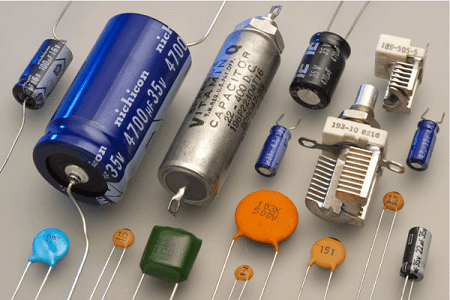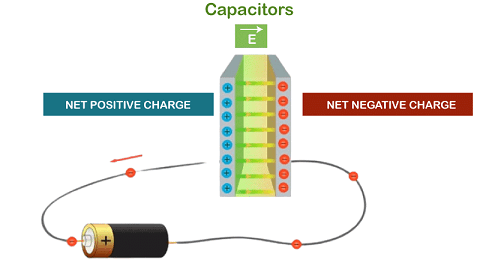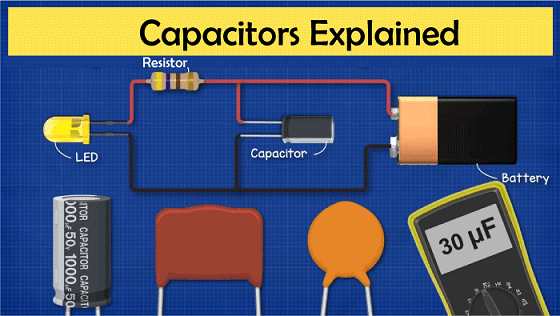What is a capacitor?
A capacitor is a passive electrical component that stores energy in an electric field. It comprises two conductive plates separated by a non-conductive material called the dielectric. When a voltage is applied to the capacitor, it accumulates charge on each plate. The amount of charge stored on each plate, and therefore the amount of energy stored in the electric field, is determined by the capacitance of the capacitor.
Capacitors are widely used in electronic circuits for a variety of purposes. One of the most common applications is coupling and decoupling circuits, where a capacitor passes AC signals while blocking DC signals. This is useful in preventing DC voltage offsets from affecting the operation of sensitive circuit components, such as amplifiers.
Another important application of capacitors is in power supply circuits, where they are used to smooth out the output of a rectifier, which converts AC voltage to DC voltage. Capacitors are also used in timing circuits, which act as a time constant, controlling the rate at which a circuit charges or discharges.

Capacitors are available in various sizes and types, with capacitance values ranging from a few picofarads to several microfarads. They are also available in various voltage ratings and with different dielectrics, such as ceramic, tantalum, and aluminum electrolytic.
Uses of Capacitor
Coupling and decoupling: Capacitors pass AC signals while blocking DC signals. This is useful in preventing DC voltage offsets from affecting the operation of sensitive circuit components, such as amplifiers.
Power supply smoothing: They are used in power supply circuits to smooth out the output of a rectifier, which converts AC voltage to DC voltage.
Timing circuits: They act as a time constant, controlling the rate at which a circuit charges or discharges. They are used in timing circuits to control the speed of motors, the rate of blinking of LEDs, and in many other applications.
Filtering: They filter out unwanted high-frequency noise in electronic circuits. They are commonly used in audio and video systems to improve signal quality.
Energy storage: Capacitors store energy quickly in applications such as flash photography, power backup systems, and electric vehicles.
Motor starting: Capacitors are used to increase the starting torque of electric motors by temporarily increasing the voltage applied to the motor.
Signal processing: Capacitors are used in signal processing circuits such as filters, oscillators, and resonant circuits.
Surge protection: They are used in surge protection circuits to absorb and dissipate transient voltage spikes.
These are some of the most common uses of capacitors, but they can also be used in many other applications, depending on the specific requirements of the circuit.
Advantages of Capacitors
High capacitance-to-volume ratio: Capacitors can store a relatively large amount of energy in a small space, making them useful in portable and compact electronic devices.
Low cost: They are relatively inexpensive and widely available, making them an affordable solution for many electronic applications.
Stable performance: Capacitors have relatively stable performance over a wide range of temperatures and frequencies, making them suitable for use in a wide range of electronic applications.
Long lifespan: Capacitors typically have a long lifespan and require little maintenance, making them reliable for electronic applications.
Versatility: Capacitors are available in various sizes, types, and capacitance values, making them suitable for various electronic applications.
Safe to use: Capacitors are passive components; they do not require any power to operate and are safe to use.
High power handling capability: They can handle high power and current, making them suitable for high-power applications such as motor starting and energy storage.
Used in AC and DC circuits: Capacitors are widely used in both AC and DC circuits and can filter out noise, reduce ripple, and smooth power in DC circuits.
Used in high voltage applications: Capacitors are available in a wide range of voltage ratings, making them suitable for high voltage applications.
Capacitors are a versatile and reliable solution for a wide range of electronic applications due to their high capacitance-to-volume ratio, low cost, stable performance, long lifespan, and ability to handle high power and voltage.
Disadvantages of Capacitors
While capacitors have many advantages, they also have limitations and disadvantages, such as limited energy storage, voltage rating, leakage current, temperature sensitivity, aging, polarization, size and weight, and limited frequency response. They can be difficult to handle. These factors must be considered when designing electronic circuits and selecting the appropriate type of capacitor for the application.
- Limited energy storage: Capacitors can store a limited amount of energy compared to other energy storage devices, such as batteries.
- Voltage rating: Capacitors have a specific voltage rating and can be damaged if exposed to excessive voltage.
- Leakage current: Capacitors can have leakage current, the amount of current that flows through the dielectric material of the capacitor. This current can cause a gradual discharge of the capacitor, reducing its effectiveness over time.
- Temperature sensitivity: The capacitance of some capacitors can change with temperature, which can affect the performance of electronic circuits.
- Aging: Capacitors may degrade over time, which can affect their performance and reliability.
- Polarization: Some types of capacitors, such as electrolytic capacitors, are polarized, meaning they must be connected to a circuit with the correct polarity to function properly.
- Size and weight: Capacitors can be relatively large and heavy, which can be a limitation in portable and compact electronic devices.
- Limited frequency response: Capacitors have limited frequency response, so their effectiveness can decrease at higher frequencies.
- Can be difficult to handle: Some types of capacitors, such as ceramic capacitors, can be fragile and difficult to handle.

Tips for using capacitors
- Choose the right type of capacitor: Different types have different characteristics and are suitable for different applications. For example, ceramic capacitors are good for coupling and decoupling, while tantalum capacitors are good for smoothing power supply ripple.
- Please choose the right capacitance value: The capacitance value of a capacitor determines how much energy it can store. It's important to choose a capacitance value appropriate for the application.
- Please choose the right voltage rating: Capacitors have a specific voltage rating, and it's important to choose a capacitor that can handle the voltage levels in the circuit.
- Observe the polarity: Some types of capacitors are polarized, meaning that they must be connected to a circuit with the correct polarity to function properly. Observe the polarity when connecting the capacitor to the circuit.
- Use capacitors in parallel to increase capacitance: You can connect multiple capacitors in parallel to increase the total capacitance in a circuit.
- Use capacitors in series to increase voltage rating: To increase the voltage rating in a circuit, you can connect multiple capacitors in series.
- Use multiple capacitors to reduce ripple: In a power supply circuit, you can use multiple capacitors of different values and types in parallel.
- Use capacitors to reduce noise: To reduce noise in a circuit, you can use capacitors to filter out unwanted high-frequency signals.
- Please pay attention to the ESR (Equivalent Series Resistance): Capacitors have ESR, which can impact the effectiveness of the capacitor in high-frequency applications, it is important to pay attention to the ESR when selecting capacitors for high-frequency applications.
- Store and handle capacitors properly: Some types of capacitors, such as ceramic capacitors, can be fragile and should be handled with care. Store capacitors in a dry and cool place to avoid damage.
Following these tips ensures that you are using capacitors most effectively in your electronic circuits.

Summary
A capacitor is a passive electronic component that stores energy in an electric field by accumulating charge on two conductive plates separated by a non-conductive material called the dielectric. They have a high capacitance-to-volume ratio, low cost, stable performance, and long lifespan. However, capacitors also have limitations such as limited energy storage, voltage rating, leakage current, temperature sensitivity, aging, polarization, size and weight, and limited frequency response, which can be difficult to handle. To use capacitors effectively in electronic circuits, it's important to choose the right type of capacitor, capacitance value, and voltage rating, observe the polarity and use multiple capacitors in parallel or series. Capacitors should also be handled and stored properly to avoid damage.